Strategic Human Resource Management Report for IBM Analysis
VerifiedAdded on 2021/02/20
|16
|5191
|368
Report
AI Summary
This report provides a comprehensive analysis of strategic human resource management (SHRM) within IBM. It begins by highlighting the importance of SHRM in organizations, emphasizing its role in attracting, developing, and retaining employees to achieve business objectives. The report explores the contribution of human resource planning in aligning with organizational goals, including staffing, employee performance maximization, and change management. It further examines how SHRM supports business strategies, fosters competitive advantages, and promotes forward-thinking initiatives. The report then delves into the business factors underpinning HR planning, such as organizational type, growth cycles, and environmental uncertainties. It also outlines HR requirements for business expansion, including the need for global management networks and standardized procedures. Finally, the report presents a proposed HR plan, analyzing organizational objectives, current resources, and demand forecasting to improve HR effectiveness within IBM. Overall, the report offers valuable insights into the strategic application of human resource management principles within a major multinational corporation.
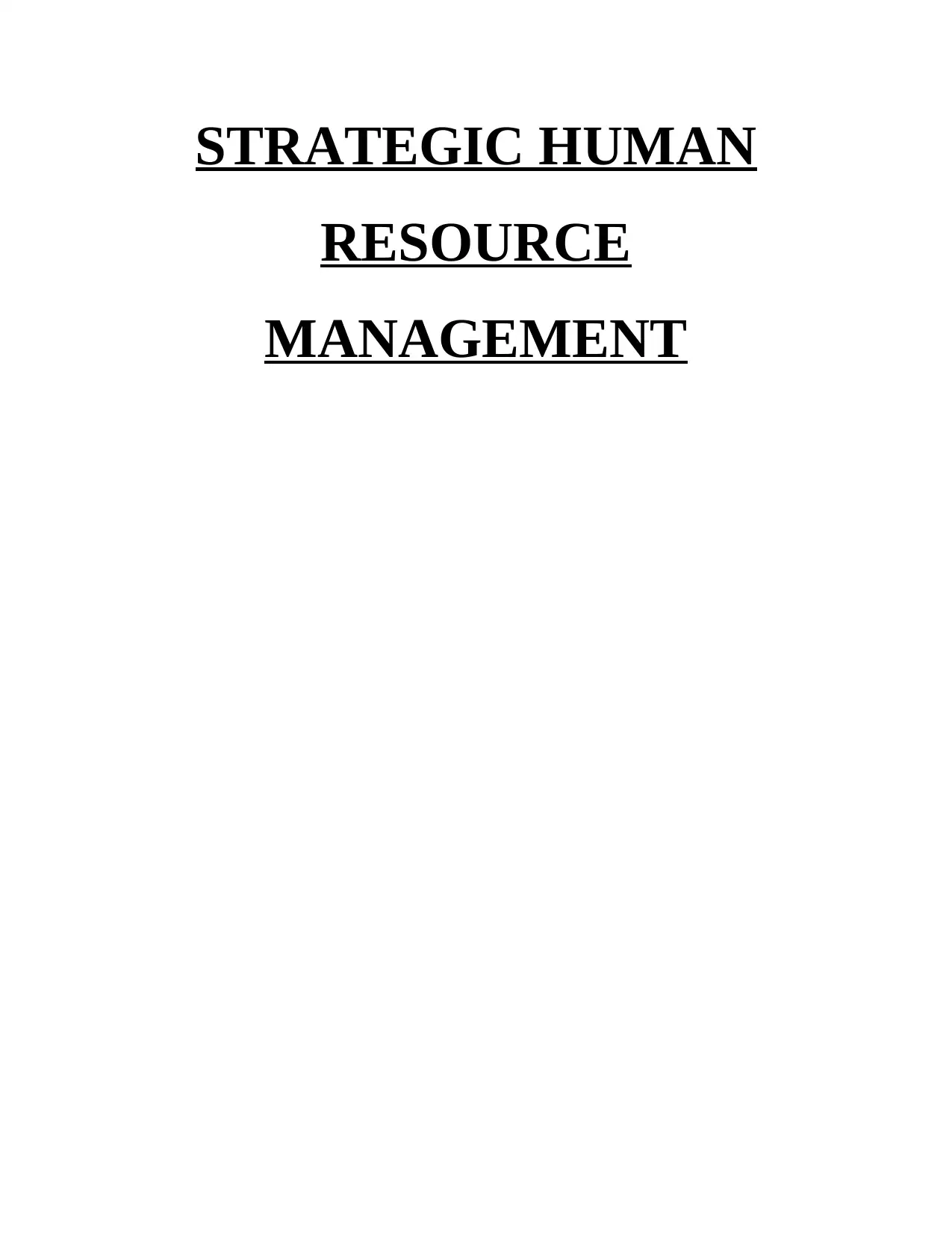
STRATEGIC HUMAN
RESOURCE
MANAGEMENT
RESOURCE
MANAGEMENT
Paraphrase This Document
Need a fresh take? Get an instant paraphrase of this document with our AI Paraphraser
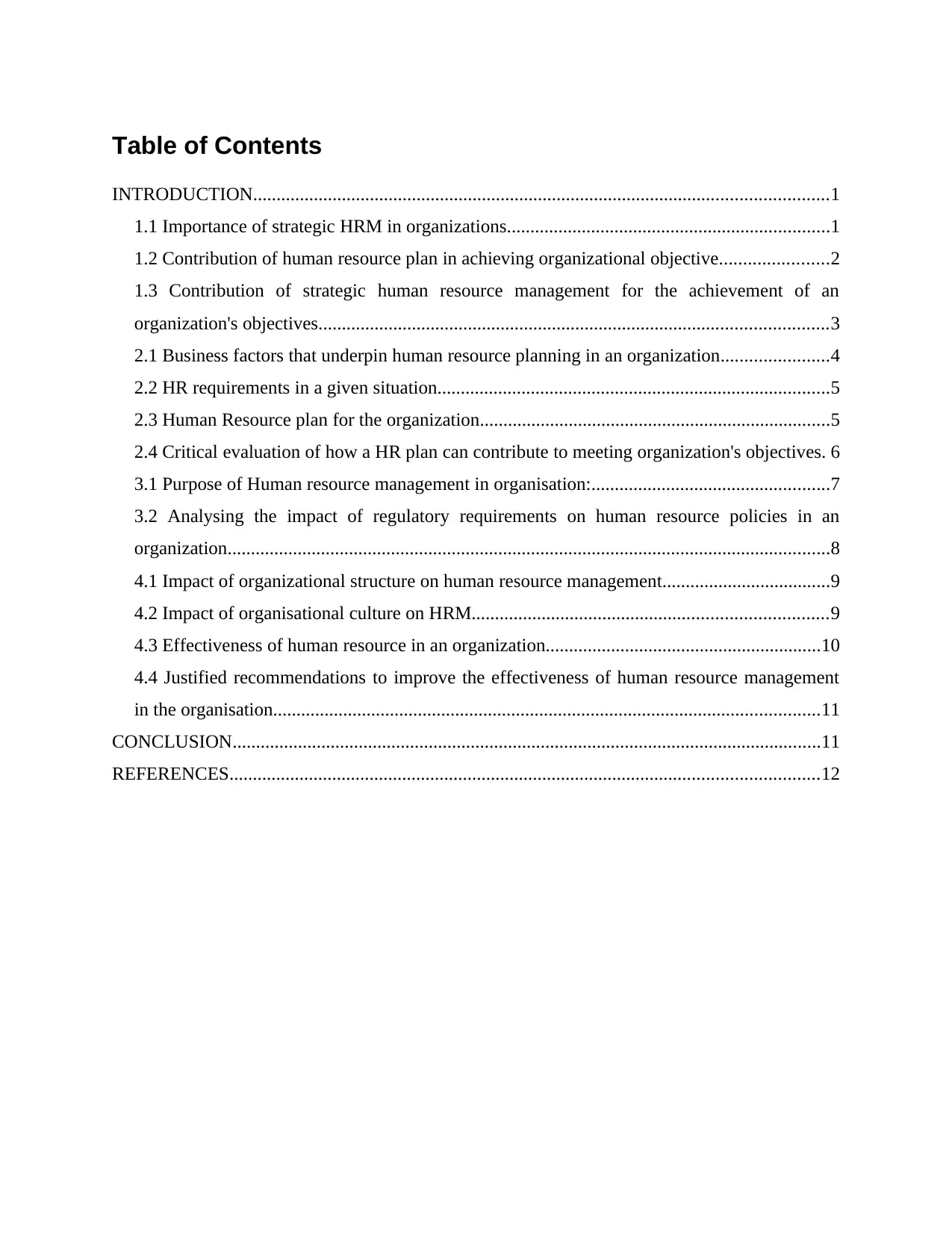
Table of Contents
INTRODUCTION...........................................................................................................................1
1.1 Importance of strategic HRM in organizations.....................................................................1
1.2 Contribution of human resource plan in achieving organizational objective.......................2
1.3 Contribution of strategic human resource management for the achievement of an
organization's objectives.............................................................................................................3
2.1 Business factors that underpin human resource planning in an organization.......................4
2.2 HR requirements in a given situation....................................................................................5
2.3 Human Resource plan for the organization...........................................................................5
2.4 Critical evaluation of how a HR plan can contribute to meeting organization's objectives. 6
3.1 Purpose of Human resource management in organisation:...................................................7
3.2 Analysing the impact of regulatory requirements on human resource policies in an
organization.................................................................................................................................8
4.1 Impact of organizational structure on human resource management....................................9
4.2 Impact of organisational culture on HRM............................................................................9
4.3 Effectiveness of human resource in an organization...........................................................10
4.4 Justified recommendations to improve the effectiveness of human resource management
in the organisation.....................................................................................................................11
CONCLUSION..............................................................................................................................11
REFERENCES..............................................................................................................................12
INTRODUCTION...........................................................................................................................1
1.1 Importance of strategic HRM in organizations.....................................................................1
1.2 Contribution of human resource plan in achieving organizational objective.......................2
1.3 Contribution of strategic human resource management for the achievement of an
organization's objectives.............................................................................................................3
2.1 Business factors that underpin human resource planning in an organization.......................4
2.2 HR requirements in a given situation....................................................................................5
2.3 Human Resource plan for the organization...........................................................................5
2.4 Critical evaluation of how a HR plan can contribute to meeting organization's objectives. 6
3.1 Purpose of Human resource management in organisation:...................................................7
3.2 Analysing the impact of regulatory requirements on human resource policies in an
organization.................................................................................................................................8
4.1 Impact of organizational structure on human resource management....................................9
4.2 Impact of organisational culture on HRM............................................................................9
4.3 Effectiveness of human resource in an organization...........................................................10
4.4 Justified recommendations to improve the effectiveness of human resource management
in the organisation.....................................................................................................................11
CONCLUSION..............................................................................................................................11
REFERENCES..............................................................................................................................12
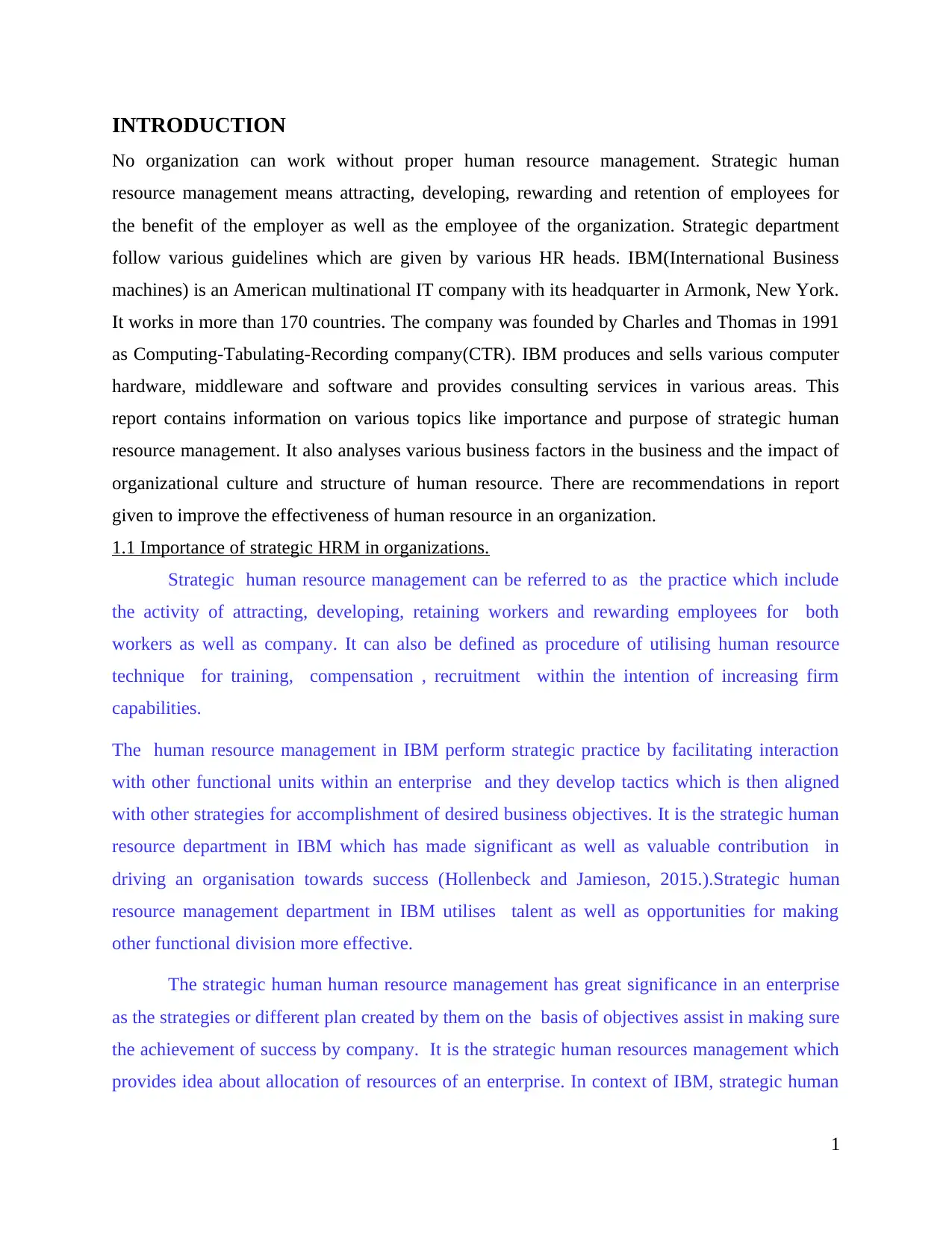
INTRODUCTION
No organization can work without proper human resource management. Strategic human
resource management means attracting, developing, rewarding and retention of employees for
the benefit of the employer as well as the employee of the organization. Strategic department
follow various guidelines which are given by various HR heads. IBM(International Business
machines) is an American multinational IT company with its headquarter in Armonk, New York.
It works in more than 170 countries. The company was founded by Charles and Thomas in 1991
as Computing-Tabulating-Recording company(CTR). IBM produces and sells various computer
hardware, middleware and software and provides consulting services in various areas. This
report contains information on various topics like importance and purpose of strategic human
resource management. It also analyses various business factors in the business and the impact of
organizational culture and structure of human resource. There are recommendations in report
given to improve the effectiveness of human resource in an organization.
1.1 Importance of strategic HRM in organizations.
Strategic human resource management can be referred to as the practice which include
the activity of attracting, developing, retaining workers and rewarding employees for both
workers as well as company. It can also be defined as procedure of utilising human resource
technique for training, compensation , recruitment within the intention of increasing firm
capabilities.
The human resource management in IBM perform strategic practice by facilitating interaction
with other functional units within an enterprise and they develop tactics which is then aligned
with other strategies for accomplishment of desired business objectives. It is the strategic human
resource department in IBM which has made significant as well as valuable contribution in
driving an organisation towards success (Hollenbeck and Jamieson, 2015.).Strategic human
resource management department in IBM utilises talent as well as opportunities for making
other functional division more effective.
The strategic human human resource management has great significance in an enterprise
as the strategies or different plan created by them on the basis of objectives assist in making sure
the achievement of success by company. It is the strategic human resources management which
provides idea about allocation of resources of an enterprise. In context of IBM, strategic human
1
No organization can work without proper human resource management. Strategic human
resource management means attracting, developing, rewarding and retention of employees for
the benefit of the employer as well as the employee of the organization. Strategic department
follow various guidelines which are given by various HR heads. IBM(International Business
machines) is an American multinational IT company with its headquarter in Armonk, New York.
It works in more than 170 countries. The company was founded by Charles and Thomas in 1991
as Computing-Tabulating-Recording company(CTR). IBM produces and sells various computer
hardware, middleware and software and provides consulting services in various areas. This
report contains information on various topics like importance and purpose of strategic human
resource management. It also analyses various business factors in the business and the impact of
organizational culture and structure of human resource. There are recommendations in report
given to improve the effectiveness of human resource in an organization.
1.1 Importance of strategic HRM in organizations.
Strategic human resource management can be referred to as the practice which include
the activity of attracting, developing, retaining workers and rewarding employees for both
workers as well as company. It can also be defined as procedure of utilising human resource
technique for training, compensation , recruitment within the intention of increasing firm
capabilities.
The human resource management in IBM perform strategic practice by facilitating interaction
with other functional units within an enterprise and they develop tactics which is then aligned
with other strategies for accomplishment of desired business objectives. It is the strategic human
resource department in IBM which has made significant as well as valuable contribution in
driving an organisation towards success (Hollenbeck and Jamieson, 2015.).Strategic human
resource management department in IBM utilises talent as well as opportunities for making
other functional division more effective.
The strategic human human resource management has great significance in an enterprise
as the strategies or different plan created by them on the basis of objectives assist in making sure
the achievement of success by company. It is the strategic human resources management which
provides idea about allocation of resources of an enterprise. In context of IBM, strategic human
1
⊘ This is a preview!⊘
Do you want full access?
Subscribe today to unlock all pages.

Trusted by 1+ million students worldwide
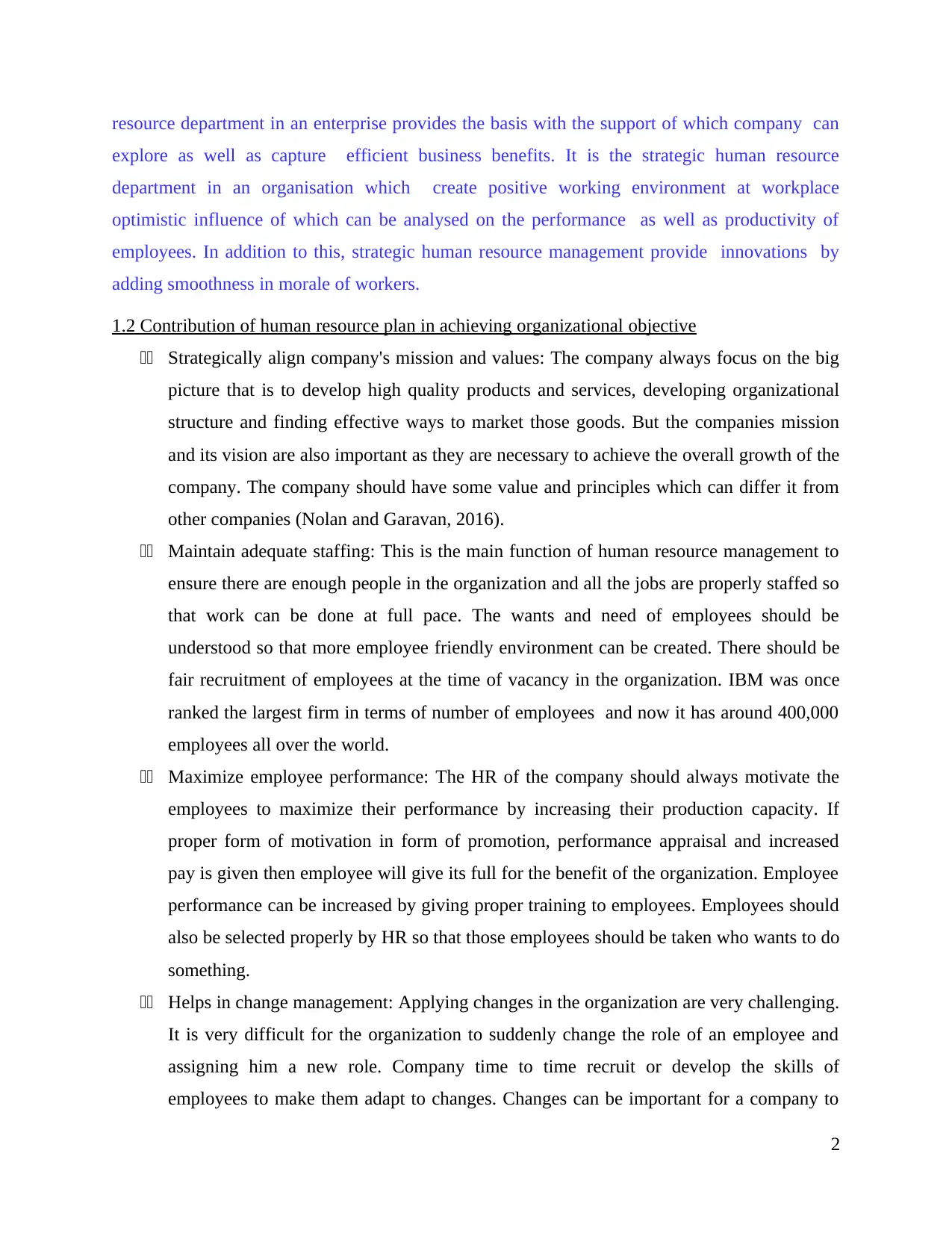
resource department in an enterprise provides the basis with the support of which company can
explore as well as capture efficient business benefits. It is the strategic human resource
department in an organisation which create positive working environment at workplace
optimistic influence of which can be analysed on the performance as well as productivity of
employees. In addition to this, strategic human resource management provide innovations by
adding smoothness in morale of workers.
1.2 Contribution of human resource plan in achieving organizational objective
11 Strategically align company's mission and values: The company always focus on the big
picture that is to develop high quality products and services, developing organizational
structure and finding effective ways to market those goods. But the companies mission
and its vision are also important as they are necessary to achieve the overall growth of the
company. The company should have some value and principles which can differ it from
other companies (Nolan and Garavan, 2016).
11 Maintain adequate staffing: This is the main function of human resource management to
ensure there are enough people in the organization and all the jobs are properly staffed so
that work can be done at full pace. The wants and need of employees should be
understood so that more employee friendly environment can be created. There should be
fair recruitment of employees at the time of vacancy in the organization. IBM was once
ranked the largest firm in terms of number of employees and now it has around 400,000
employees all over the world.
11 Maximize employee performance: The HR of the company should always motivate the
employees to maximize their performance by increasing their production capacity. If
proper form of motivation in form of promotion, performance appraisal and increased
pay is given then employee will give its full for the benefit of the organization. Employee
performance can be increased by giving proper training to employees. Employees should
also be selected properly by HR so that those employees should be taken who wants to do
something.
11 Helps in change management: Applying changes in the organization are very challenging.
It is very difficult for the organization to suddenly change the role of an employee and
assigning him a new role. Company time to time recruit or develop the skills of
employees to make them adapt to changes. Changes can be important for a company to
2
explore as well as capture efficient business benefits. It is the strategic human resource
department in an organisation which create positive working environment at workplace
optimistic influence of which can be analysed on the performance as well as productivity of
employees. In addition to this, strategic human resource management provide innovations by
adding smoothness in morale of workers.
1.2 Contribution of human resource plan in achieving organizational objective
11 Strategically align company's mission and values: The company always focus on the big
picture that is to develop high quality products and services, developing organizational
structure and finding effective ways to market those goods. But the companies mission
and its vision are also important as they are necessary to achieve the overall growth of the
company. The company should have some value and principles which can differ it from
other companies (Nolan and Garavan, 2016).
11 Maintain adequate staffing: This is the main function of human resource management to
ensure there are enough people in the organization and all the jobs are properly staffed so
that work can be done at full pace. The wants and need of employees should be
understood so that more employee friendly environment can be created. There should be
fair recruitment of employees at the time of vacancy in the organization. IBM was once
ranked the largest firm in terms of number of employees and now it has around 400,000
employees all over the world.
11 Maximize employee performance: The HR of the company should always motivate the
employees to maximize their performance by increasing their production capacity. If
proper form of motivation in form of promotion, performance appraisal and increased
pay is given then employee will give its full for the benefit of the organization. Employee
performance can be increased by giving proper training to employees. Employees should
also be selected properly by HR so that those employees should be taken who wants to do
something.
11 Helps in change management: Applying changes in the organization are very challenging.
It is very difficult for the organization to suddenly change the role of an employee and
assigning him a new role. Company time to time recruit or develop the skills of
employees to make them adapt to changes. Changes can be important for a company to
2
Paraphrase This Document
Need a fresh take? Get an instant paraphrase of this document with our AI Paraphraser
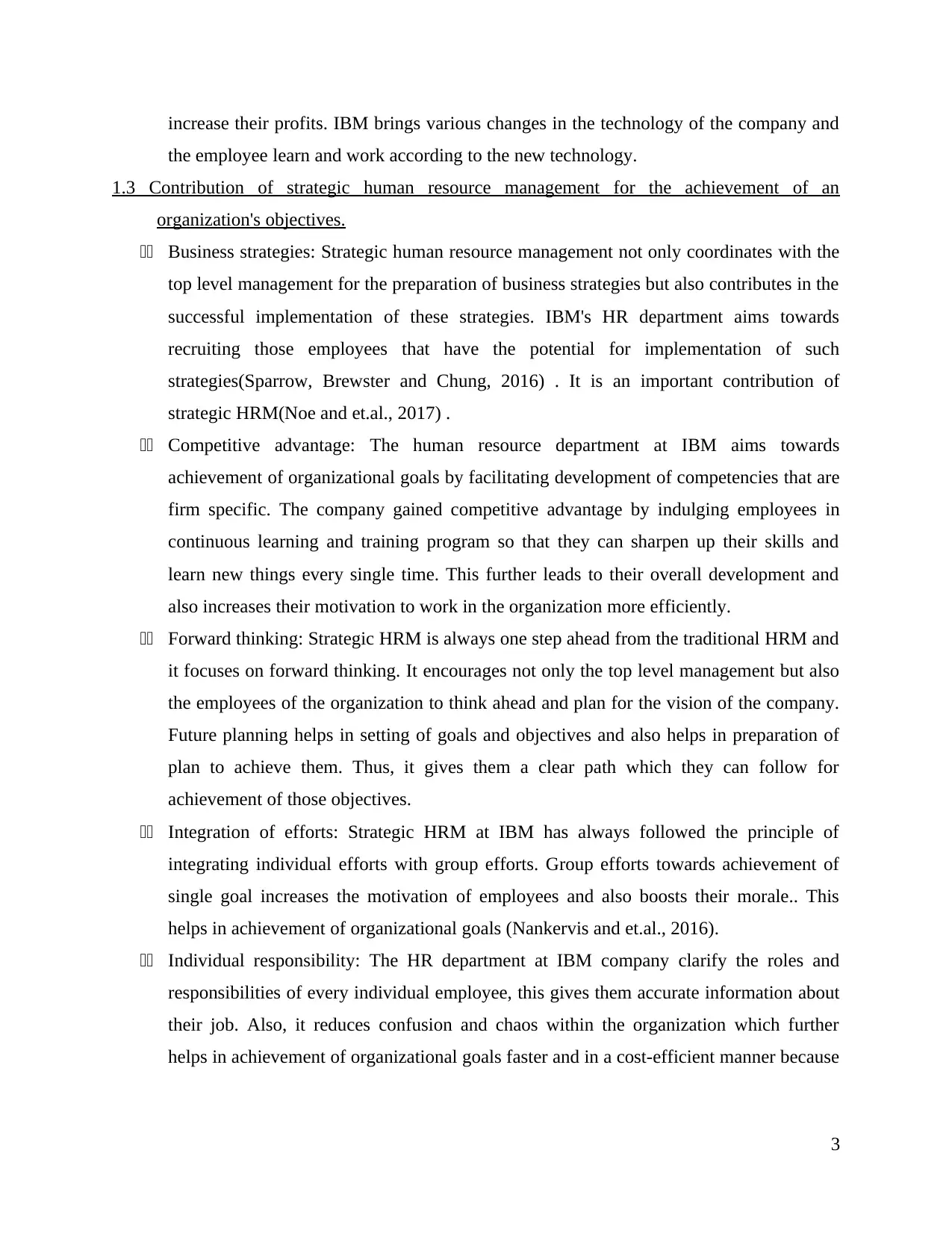
increase their profits. IBM brings various changes in the technology of the company and
the employee learn and work according to the new technology.
1.3 Contribution of strategic human resource management for the achievement of an
organization's objectives.
11 Business strategies: Strategic human resource management not only coordinates with the
top level management for the preparation of business strategies but also contributes in the
successful implementation of these strategies. IBM's HR department aims towards
recruiting those employees that have the potential for implementation of such
strategies(Sparrow, Brewster and Chung, 2016) . It is an important contribution of
strategic HRM(Noe and et.al., 2017) .
11 Competitive advantage: The human resource department at IBM aims towards
achievement of organizational goals by facilitating development of competencies that are
firm specific. The company gained competitive advantage by indulging employees in
continuous learning and training program so that they can sharpen up their skills and
learn new things every single time. This further leads to their overall development and
also increases their motivation to work in the organization more efficiently.
11 Forward thinking: Strategic HRM is always one step ahead from the traditional HRM and
it focuses on forward thinking. It encourages not only the top level management but also
the employees of the organization to think ahead and plan for the vision of the company.
Future planning helps in setting of goals and objectives and also helps in preparation of
plan to achieve them. Thus, it gives them a clear path which they can follow for
achievement of those objectives.
11 Integration of efforts: Strategic HRM at IBM has always followed the principle of
integrating individual efforts with group efforts. Group efforts towards achievement of
single goal increases the motivation of employees and also boosts their morale.. This
helps in achievement of organizational goals (Nankervis and et.al., 2016).
11 Individual responsibility: The HR department at IBM company clarify the roles and
responsibilities of every individual employee, this gives them accurate information about
their job. Also, it reduces confusion and chaos within the organization which further
helps in achievement of organizational goals faster and in a cost-efficient manner because
3
the employee learn and work according to the new technology.
1.3 Contribution of strategic human resource management for the achievement of an
organization's objectives.
11 Business strategies: Strategic human resource management not only coordinates with the
top level management for the preparation of business strategies but also contributes in the
successful implementation of these strategies. IBM's HR department aims towards
recruiting those employees that have the potential for implementation of such
strategies(Sparrow, Brewster and Chung, 2016) . It is an important contribution of
strategic HRM(Noe and et.al., 2017) .
11 Competitive advantage: The human resource department at IBM aims towards
achievement of organizational goals by facilitating development of competencies that are
firm specific. The company gained competitive advantage by indulging employees in
continuous learning and training program so that they can sharpen up their skills and
learn new things every single time. This further leads to their overall development and
also increases their motivation to work in the organization more efficiently.
11 Forward thinking: Strategic HRM is always one step ahead from the traditional HRM and
it focuses on forward thinking. It encourages not only the top level management but also
the employees of the organization to think ahead and plan for the vision of the company.
Future planning helps in setting of goals and objectives and also helps in preparation of
plan to achieve them. Thus, it gives them a clear path which they can follow for
achievement of those objectives.
11 Integration of efforts: Strategic HRM at IBM has always followed the principle of
integrating individual efforts with group efforts. Group efforts towards achievement of
single goal increases the motivation of employees and also boosts their morale.. This
helps in achievement of organizational goals (Nankervis and et.al., 2016).
11 Individual responsibility: The HR department at IBM company clarify the roles and
responsibilities of every individual employee, this gives them accurate information about
their job. Also, it reduces confusion and chaos within the organization which further
helps in achievement of organizational goals faster and in a cost-efficient manner because
3
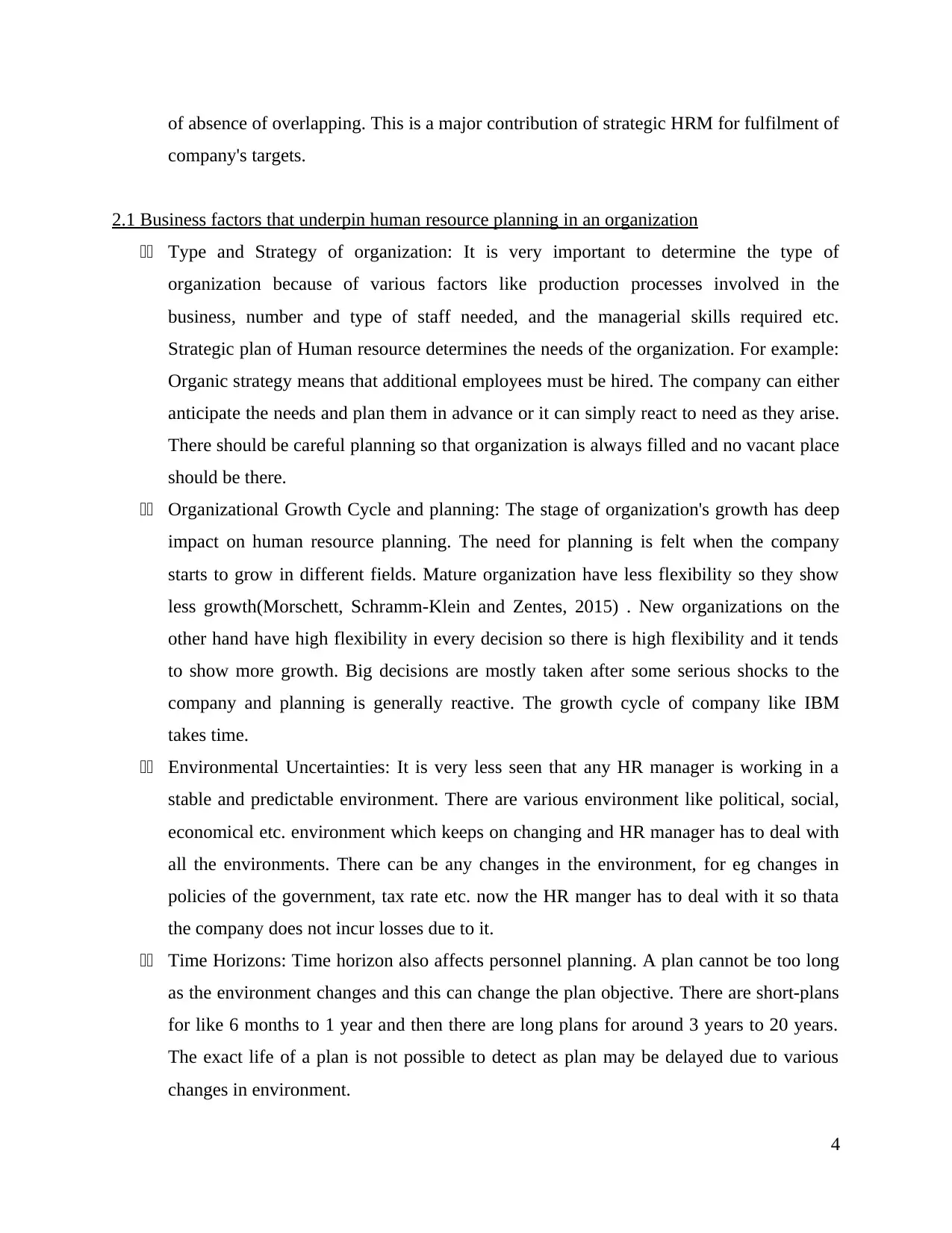
of absence of overlapping. This is a major contribution of strategic HRM for fulfilment of
company's targets.
2.1 Business factors that underpin human resource planning in an organization
11 Type and Strategy of organization: It is very important to determine the type of
organization because of various factors like production processes involved in the
business, number and type of staff needed, and the managerial skills required etc.
Strategic plan of Human resource determines the needs of the organization. For example:
Organic strategy means that additional employees must be hired. The company can either
anticipate the needs and plan them in advance or it can simply react to need as they arise.
There should be careful planning so that organization is always filled and no vacant place
should be there.
11 Organizational Growth Cycle and planning: The stage of organization's growth has deep
impact on human resource planning. The need for planning is felt when the company
starts to grow in different fields. Mature organization have less flexibility so they show
less growth(Morschett, Schramm-Klein and Zentes, 2015) . New organizations on the
other hand have high flexibility in every decision so there is high flexibility and it tends
to show more growth. Big decisions are mostly taken after some serious shocks to the
company and planning is generally reactive. The growth cycle of company like IBM
takes time.
11 Environmental Uncertainties: It is very less seen that any HR manager is working in a
stable and predictable environment. There are various environment like political, social,
economical etc. environment which keeps on changing and HR manager has to deal with
all the environments. There can be any changes in the environment, for eg changes in
policies of the government, tax rate etc. now the HR manger has to deal with it so thata
the company does not incur losses due to it.
11 Time Horizons: Time horizon also affects personnel planning. A plan cannot be too long
as the environment changes and this can change the plan objective. There are short-plans
for like 6 months to 1 year and then there are long plans for around 3 years to 20 years.
The exact life of a plan is not possible to detect as plan may be delayed due to various
changes in environment.
4
company's targets.
2.1 Business factors that underpin human resource planning in an organization
11 Type and Strategy of organization: It is very important to determine the type of
organization because of various factors like production processes involved in the
business, number and type of staff needed, and the managerial skills required etc.
Strategic plan of Human resource determines the needs of the organization. For example:
Organic strategy means that additional employees must be hired. The company can either
anticipate the needs and plan them in advance or it can simply react to need as they arise.
There should be careful planning so that organization is always filled and no vacant place
should be there.
11 Organizational Growth Cycle and planning: The stage of organization's growth has deep
impact on human resource planning. The need for planning is felt when the company
starts to grow in different fields. Mature organization have less flexibility so they show
less growth(Morschett, Schramm-Klein and Zentes, 2015) . New organizations on the
other hand have high flexibility in every decision so there is high flexibility and it tends
to show more growth. Big decisions are mostly taken after some serious shocks to the
company and planning is generally reactive. The growth cycle of company like IBM
takes time.
11 Environmental Uncertainties: It is very less seen that any HR manager is working in a
stable and predictable environment. There are various environment like political, social,
economical etc. environment which keeps on changing and HR manager has to deal with
all the environments. There can be any changes in the environment, for eg changes in
policies of the government, tax rate etc. now the HR manger has to deal with it so thata
the company does not incur losses due to it.
11 Time Horizons: Time horizon also affects personnel planning. A plan cannot be too long
as the environment changes and this can change the plan objective. There are short-plans
for like 6 months to 1 year and then there are long plans for around 3 years to 20 years.
The exact life of a plan is not possible to detect as plan may be delayed due to various
changes in environment.
4
⊘ This is a preview!⊘
Do you want full access?
Subscribe today to unlock all pages.

Trusted by 1+ million students worldwide
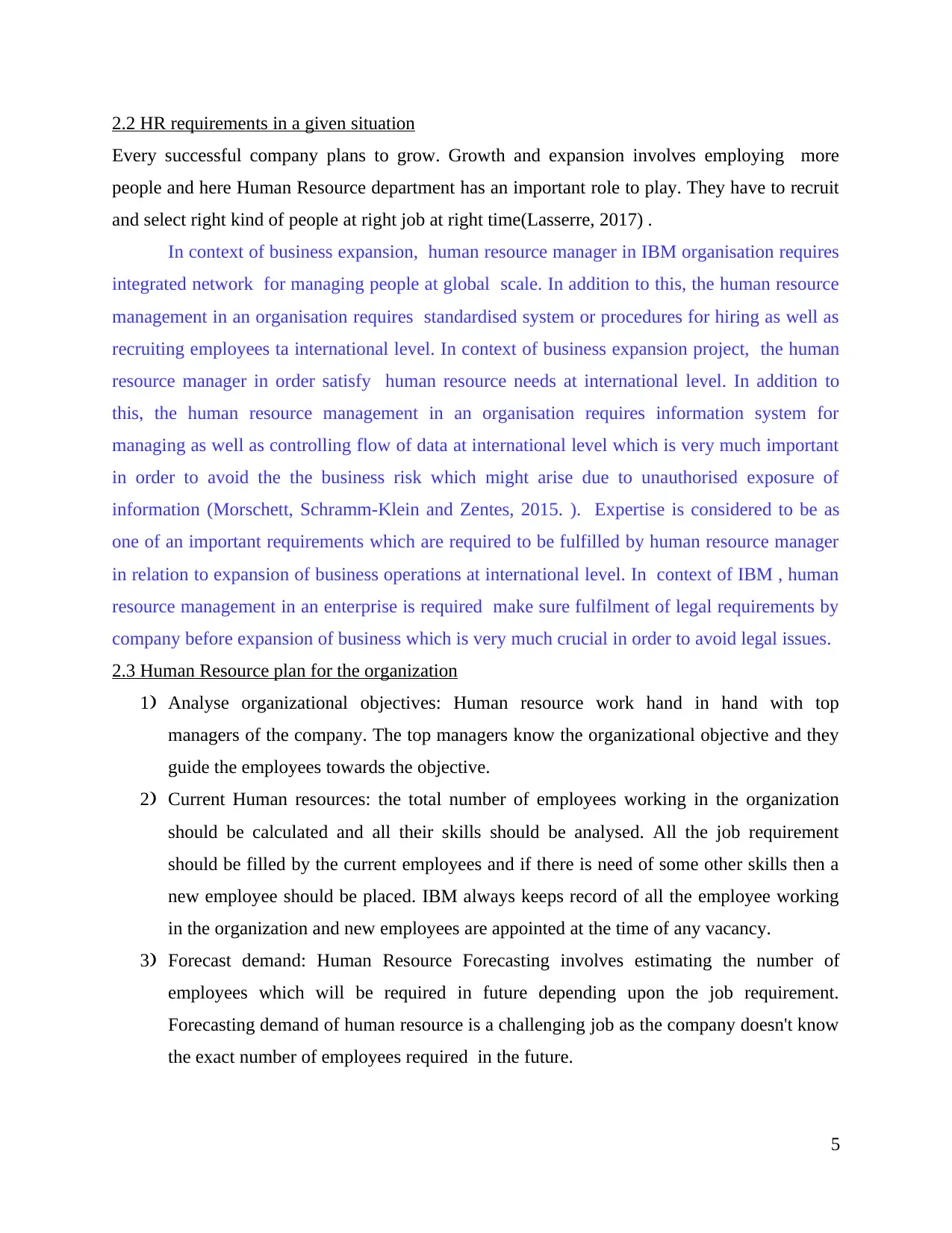
2.2 HR requirements in a given situation
Every successful company plans to grow. Growth and expansion involves employing more
people and here Human Resource department has an important role to play. They have to recruit
and select right kind of people at right job at right time(Lasserre, 2017) .
In context of business expansion, human resource manager in IBM organisation requires
integrated network for managing people at global scale. In addition to this, the human resource
management in an organisation requires standardised system or procedures for hiring as well as
recruiting employees ta international level. In context of business expansion project, the human
resource manager in order satisfy human resource needs at international level. In addition to
this, the human resource management in an organisation requires information system for
managing as well as controlling flow of data at international level which is very much important
in order to avoid the the business risk which might arise due to unauthorised exposure of
information (Morschett, Schramm-Klein and Zentes, 2015. ). Expertise is considered to be as
one of an important requirements which are required to be fulfilled by human resource manager
in relation to expansion of business operations at international level. In context of IBM , human
resource management in an enterprise is required make sure fulfilment of legal requirements by
company before expansion of business which is very much crucial in order to avoid legal issues.
2.3 Human Resource plan for the organization
1) Analyse organizational objectives: Human resource work hand in hand with top
managers of the company. The top managers know the organizational objective and they
guide the employees towards the objective.
2) Current Human resources: the total number of employees working in the organization
should be calculated and all their skills should be analysed. All the job requirement
should be filled by the current employees and if there is need of some other skills then a
new employee should be placed. IBM always keeps record of all the employee working
in the organization and new employees are appointed at the time of any vacancy.
3) Forecast demand: Human Resource Forecasting involves estimating the number of
employees which will be required in future depending upon the job requirement.
Forecasting demand of human resource is a challenging job as the company doesn't know
the exact number of employees required in the future.
5
Every successful company plans to grow. Growth and expansion involves employing more
people and here Human Resource department has an important role to play. They have to recruit
and select right kind of people at right job at right time(Lasserre, 2017) .
In context of business expansion, human resource manager in IBM organisation requires
integrated network for managing people at global scale. In addition to this, the human resource
management in an organisation requires standardised system or procedures for hiring as well as
recruiting employees ta international level. In context of business expansion project, the human
resource manager in order satisfy human resource needs at international level. In addition to
this, the human resource management in an organisation requires information system for
managing as well as controlling flow of data at international level which is very much important
in order to avoid the the business risk which might arise due to unauthorised exposure of
information (Morschett, Schramm-Klein and Zentes, 2015. ). Expertise is considered to be as
one of an important requirements which are required to be fulfilled by human resource manager
in relation to expansion of business operations at international level. In context of IBM , human
resource management in an enterprise is required make sure fulfilment of legal requirements by
company before expansion of business which is very much crucial in order to avoid legal issues.
2.3 Human Resource plan for the organization
1) Analyse organizational objectives: Human resource work hand in hand with top
managers of the company. The top managers know the organizational objective and they
guide the employees towards the objective.
2) Current Human resources: the total number of employees working in the organization
should be calculated and all their skills should be analysed. All the job requirement
should be filled by the current employees and if there is need of some other skills then a
new employee should be placed. IBM always keeps record of all the employee working
in the organization and new employees are appointed at the time of any vacancy.
3) Forecast demand: Human Resource Forecasting involves estimating the number of
employees which will be required in future depending upon the job requirement.
Forecasting demand of human resource is a challenging job as the company doesn't know
the exact number of employees required in the future.
5
Paraphrase This Document
Need a fresh take? Get an instant paraphrase of this document with our AI Paraphraser
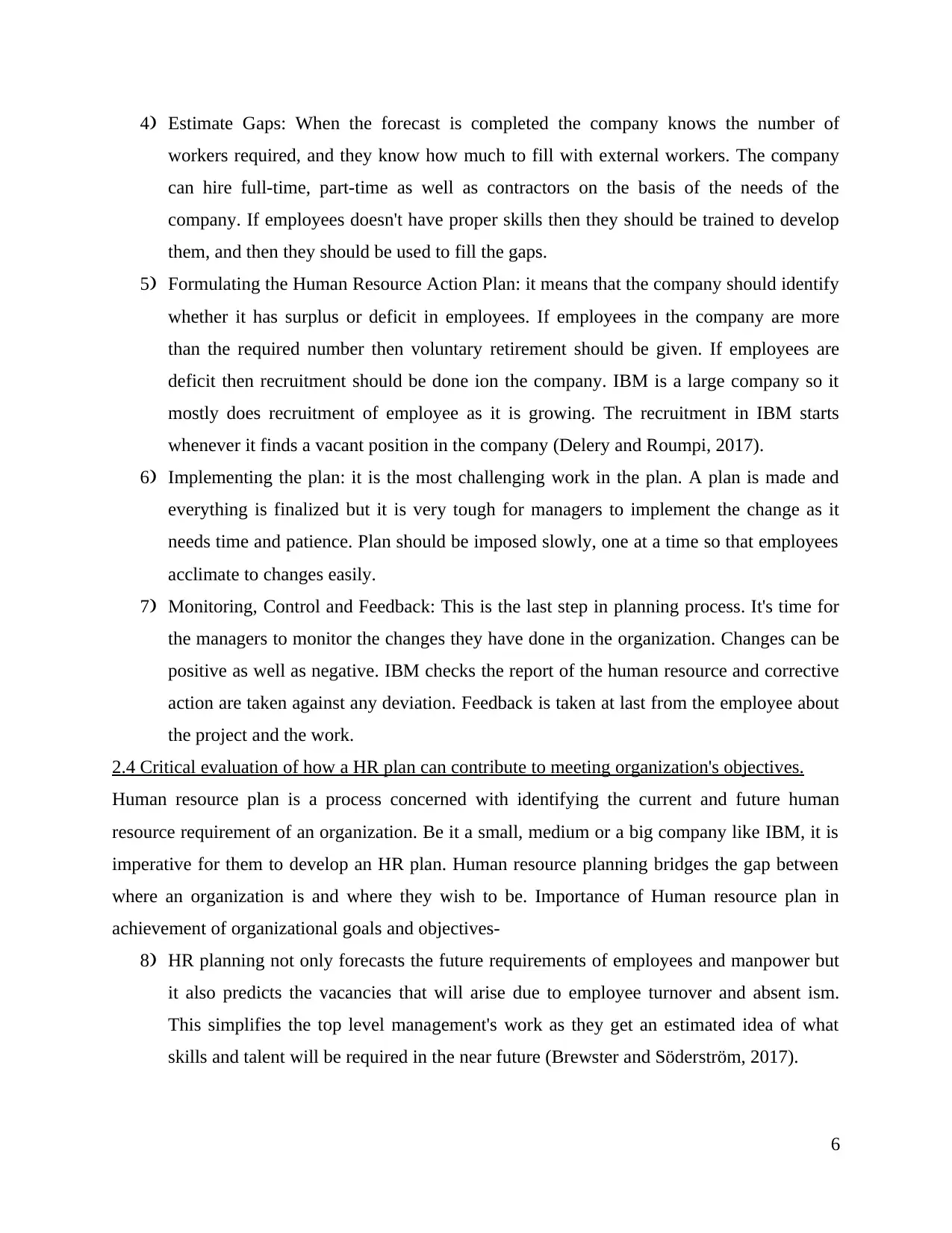
4) Estimate Gaps: When the forecast is completed the company knows the number of
workers required, and they know how much to fill with external workers. The company
can hire full-time, part-time as well as contractors on the basis of the needs of the
company. If employees doesn't have proper skills then they should be trained to develop
them, and then they should be used to fill the gaps.
5) Formulating the Human Resource Action Plan: it means that the company should identify
whether it has surplus or deficit in employees. If employees in the company are more
than the required number then voluntary retirement should be given. If employees are
deficit then recruitment should be done ion the company. IBM is a large company so it
mostly does recruitment of employee as it is growing. The recruitment in IBM starts
whenever it finds a vacant position in the company (Delery and Roumpi, 2017).
6) Implementing the plan: it is the most challenging work in the plan. A plan is made and
everything is finalized but it is very tough for managers to implement the change as it
needs time and patience. Plan should be imposed slowly, one at a time so that employees
acclimate to changes easily.
7) Monitoring, Control and Feedback: This is the last step in planning process. It's time for
the managers to monitor the changes they have done in the organization. Changes can be
positive as well as negative. IBM checks the report of the human resource and corrective
action are taken against any deviation. Feedback is taken at last from the employee about
the project and the work.
2.4 Critical evaluation of how a HR plan can contribute to meeting organization's objectives.
Human resource plan is a process concerned with identifying the current and future human
resource requirement of an organization. Be it a small, medium or a big company like IBM, it is
imperative for them to develop an HR plan. Human resource planning bridges the gap between
where an organization is and where they wish to be. Importance of Human resource plan in
achievement of organizational goals and objectives-
8) HR planning not only forecasts the future requirements of employees and manpower but
it also predicts the vacancies that will arise due to employee turnover and absent ism.
This simplifies the top level management's work as they get an estimated idea of what
skills and talent will be required in the near future (Brewster and Söderström, 2017).
6
workers required, and they know how much to fill with external workers. The company
can hire full-time, part-time as well as contractors on the basis of the needs of the
company. If employees doesn't have proper skills then they should be trained to develop
them, and then they should be used to fill the gaps.
5) Formulating the Human Resource Action Plan: it means that the company should identify
whether it has surplus or deficit in employees. If employees in the company are more
than the required number then voluntary retirement should be given. If employees are
deficit then recruitment should be done ion the company. IBM is a large company so it
mostly does recruitment of employee as it is growing. The recruitment in IBM starts
whenever it finds a vacant position in the company (Delery and Roumpi, 2017).
6) Implementing the plan: it is the most challenging work in the plan. A plan is made and
everything is finalized but it is very tough for managers to implement the change as it
needs time and patience. Plan should be imposed slowly, one at a time so that employees
acclimate to changes easily.
7) Monitoring, Control and Feedback: This is the last step in planning process. It's time for
the managers to monitor the changes they have done in the organization. Changes can be
positive as well as negative. IBM checks the report of the human resource and corrective
action are taken against any deviation. Feedback is taken at last from the employee about
the project and the work.
2.4 Critical evaluation of how a HR plan can contribute to meeting organization's objectives.
Human resource plan is a process concerned with identifying the current and future human
resource requirement of an organization. Be it a small, medium or a big company like IBM, it is
imperative for them to develop an HR plan. Human resource planning bridges the gap between
where an organization is and where they wish to be. Importance of Human resource plan in
achievement of organizational goals and objectives-
8) HR planning not only forecasts the future requirements of employees and manpower but
it also predicts the vacancies that will arise due to employee turnover and absent ism.
This simplifies the top level management's work as they get an estimated idea of what
skills and talent will be required in the near future (Brewster and Söderström, 2017).
6
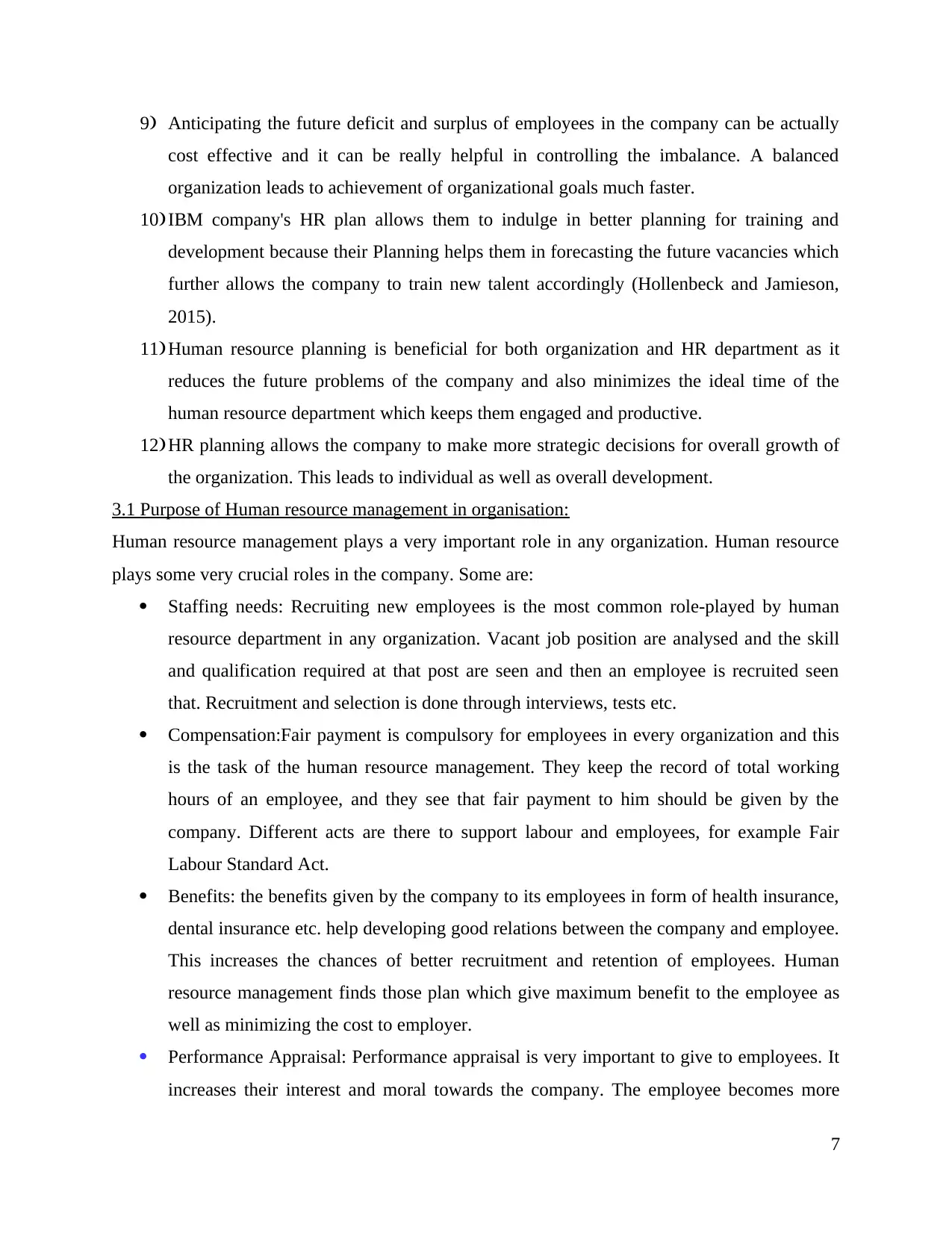
9) Anticipating the future deficit and surplus of employees in the company can be actually
cost effective and it can be really helpful in controlling the imbalance. A balanced
organization leads to achievement of organizational goals much faster.
10) IBM company's HR plan allows them to indulge in better planning for training and
development because their Planning helps them in forecasting the future vacancies which
further allows the company to train new talent accordingly (Hollenbeck and Jamieson,
2015).
11) Human resource planning is beneficial for both organization and HR department as it
reduces the future problems of the company and also minimizes the ideal time of the
human resource department which keeps them engaged and productive.
12) HR planning allows the company to make more strategic decisions for overall growth of
the organization. This leads to individual as well as overall development.
3.1 Purpose of Human resource management in organisation:
Human resource management plays a very important role in any organization. Human resource
plays some very crucial roles in the company. Some are:
Staffing needs: Recruiting new employees is the most common role-played by human
resource department in any organization. Vacant job position are analysed and the skill
and qualification required at that post are seen and then an employee is recruited seen
that. Recruitment and selection is done through interviews, tests etc.
Compensation:Fair payment is compulsory for employees in every organization and this
is the task of the human resource management. They keep the record of total working
hours of an employee, and they see that fair payment to him should be given by the
company. Different acts are there to support labour and employees, for example Fair
Labour Standard Act.
Benefits: the benefits given by the company to its employees in form of health insurance,
dental insurance etc. help developing good relations between the company and employee.
This increases the chances of better recruitment and retention of employees. Human
resource management finds those plan which give maximum benefit to the employee as
well as minimizing the cost to employer.
Performance Appraisal: Performance appraisal is very important to give to employees. It
increases their interest and moral towards the company. The employee becomes more
7
cost effective and it can be really helpful in controlling the imbalance. A balanced
organization leads to achievement of organizational goals much faster.
10) IBM company's HR plan allows them to indulge in better planning for training and
development because their Planning helps them in forecasting the future vacancies which
further allows the company to train new talent accordingly (Hollenbeck and Jamieson,
2015).
11) Human resource planning is beneficial for both organization and HR department as it
reduces the future problems of the company and also minimizes the ideal time of the
human resource department which keeps them engaged and productive.
12) HR planning allows the company to make more strategic decisions for overall growth of
the organization. This leads to individual as well as overall development.
3.1 Purpose of Human resource management in organisation:
Human resource management plays a very important role in any organization. Human resource
plays some very crucial roles in the company. Some are:
Staffing needs: Recruiting new employees is the most common role-played by human
resource department in any organization. Vacant job position are analysed and the skill
and qualification required at that post are seen and then an employee is recruited seen
that. Recruitment and selection is done through interviews, tests etc.
Compensation:Fair payment is compulsory for employees in every organization and this
is the task of the human resource management. They keep the record of total working
hours of an employee, and they see that fair payment to him should be given by the
company. Different acts are there to support labour and employees, for example Fair
Labour Standard Act.
Benefits: the benefits given by the company to its employees in form of health insurance,
dental insurance etc. help developing good relations between the company and employee.
This increases the chances of better recruitment and retention of employees. Human
resource management finds those plan which give maximum benefit to the employee as
well as minimizing the cost to employer.
Performance Appraisal: Performance appraisal is very important to give to employees. It
increases their interest and moral towards the company. The employee becomes more
7
⊘ This is a preview!⊘
Do you want full access?
Subscribe today to unlock all pages.

Trusted by 1+ million students worldwide
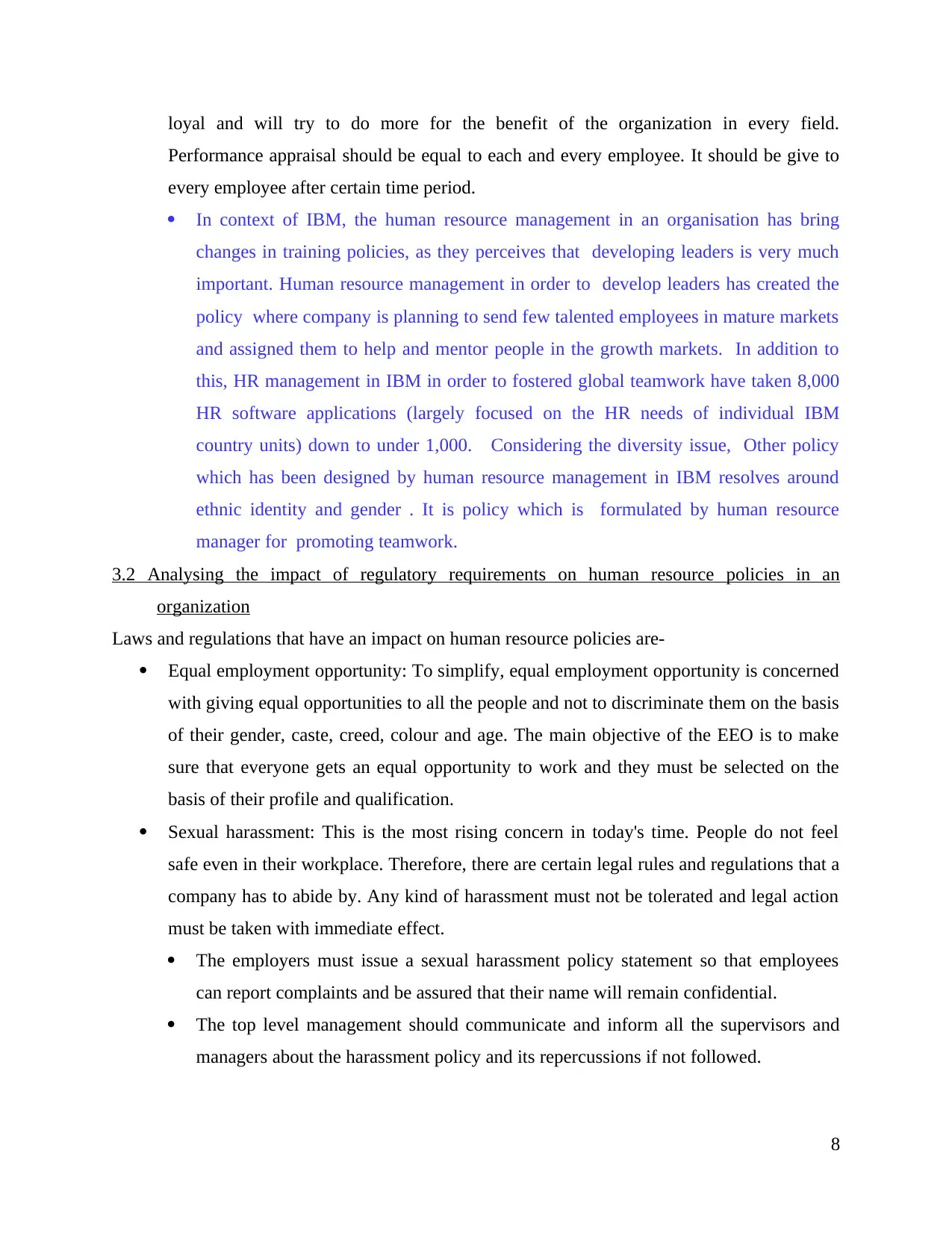
loyal and will try to do more for the benefit of the organization in every field.
Performance appraisal should be equal to each and every employee. It should be give to
every employee after certain time period.
In context of IBM, the human resource management in an organisation has bring
changes in training policies, as they perceives that developing leaders is very much
important. Human resource management in order to develop leaders has created the
policy where company is planning to send few talented employees in mature markets
and assigned them to help and mentor people in the growth markets. In addition to
this, HR management in IBM in order to fostered global teamwork have taken 8,000
HR software applications (largely focused on the HR needs of individual IBM
country units) down to under 1,000. Considering the diversity issue, Other policy
which has been designed by human resource management in IBM resolves around
ethnic identity and gender . It is policy which is formulated by human resource
manager for promoting teamwork.
3.2 Analysing the impact of regulatory requirements on human resource policies in an
organization
Laws and regulations that have an impact on human resource policies are-
Equal employment opportunity: To simplify, equal employment opportunity is concerned
with giving equal opportunities to all the people and not to discriminate them on the basis
of their gender, caste, creed, colour and age. The main objective of the EEO is to make
sure that everyone gets an equal opportunity to work and they must be selected on the
basis of their profile and qualification.
Sexual harassment: This is the most rising concern in today's time. People do not feel
safe even in their workplace. Therefore, there are certain legal rules and regulations that a
company has to abide by. Any kind of harassment must not be tolerated and legal action
must be taken with immediate effect.
The employers must issue a sexual harassment policy statement so that employees
can report complaints and be assured that their name will remain confidential.
The top level management should communicate and inform all the supervisors and
managers about the harassment policy and its repercussions if not followed.
8
Performance appraisal should be equal to each and every employee. It should be give to
every employee after certain time period.
In context of IBM, the human resource management in an organisation has bring
changes in training policies, as they perceives that developing leaders is very much
important. Human resource management in order to develop leaders has created the
policy where company is planning to send few talented employees in mature markets
and assigned them to help and mentor people in the growth markets. In addition to
this, HR management in IBM in order to fostered global teamwork have taken 8,000
HR software applications (largely focused on the HR needs of individual IBM
country units) down to under 1,000. Considering the diversity issue, Other policy
which has been designed by human resource management in IBM resolves around
ethnic identity and gender . It is policy which is formulated by human resource
manager for promoting teamwork.
3.2 Analysing the impact of regulatory requirements on human resource policies in an
organization
Laws and regulations that have an impact on human resource policies are-
Equal employment opportunity: To simplify, equal employment opportunity is concerned
with giving equal opportunities to all the people and not to discriminate them on the basis
of their gender, caste, creed, colour and age. The main objective of the EEO is to make
sure that everyone gets an equal opportunity to work and they must be selected on the
basis of their profile and qualification.
Sexual harassment: This is the most rising concern in today's time. People do not feel
safe even in their workplace. Therefore, there are certain legal rules and regulations that a
company has to abide by. Any kind of harassment must not be tolerated and legal action
must be taken with immediate effect.
The employers must issue a sexual harassment policy statement so that employees
can report complaints and be assured that their name will remain confidential.
The top level management should communicate and inform all the supervisors and
managers about the harassment policy and its repercussions if not followed.
8
Paraphrase This Document
Need a fresh take? Get an instant paraphrase of this document with our AI Paraphraser
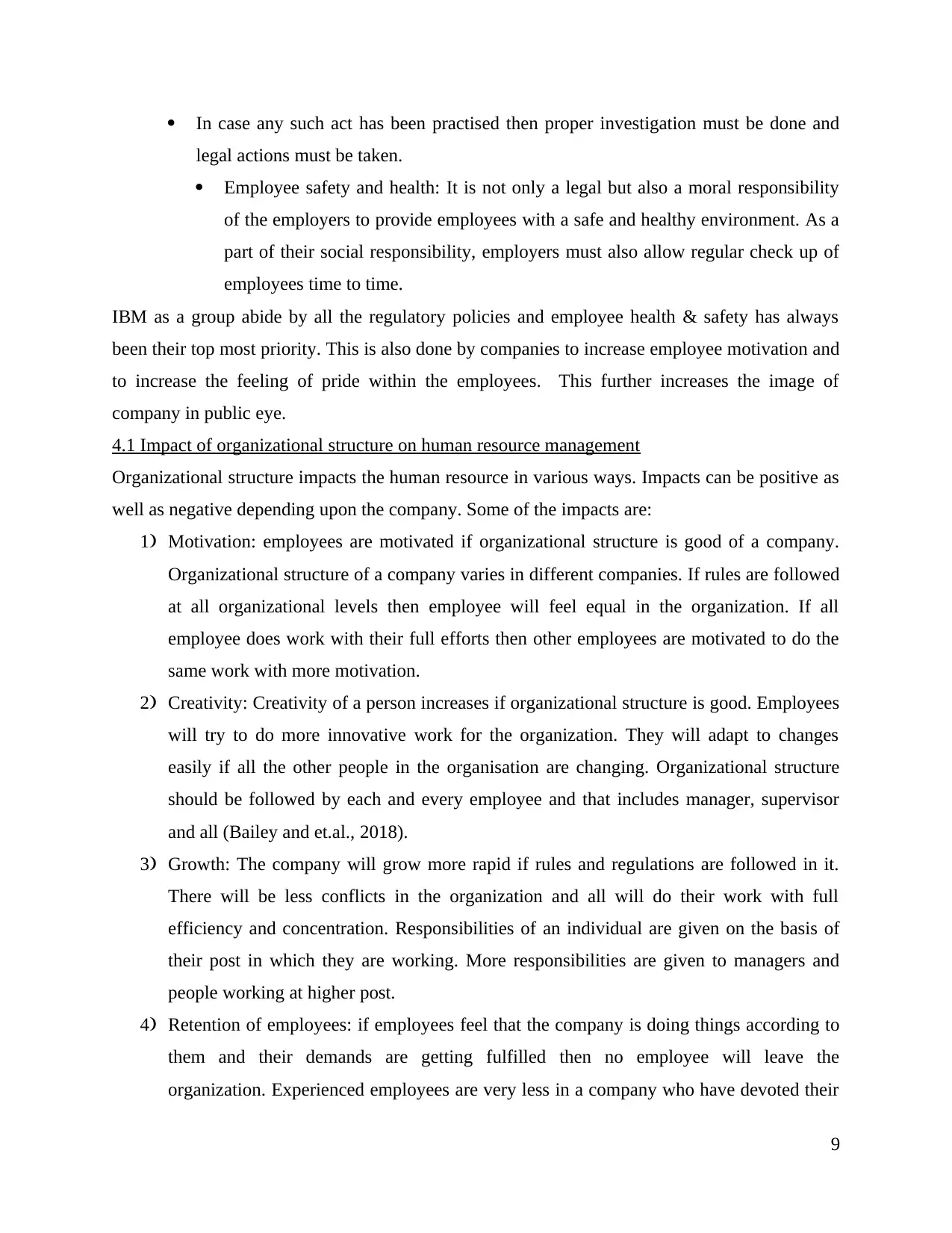
In case any such act has been practised then proper investigation must be done and
legal actions must be taken.
Employee safety and health: It is not only a legal but also a moral responsibility
of the employers to provide employees with a safe and healthy environment. As a
part of their social responsibility, employers must also allow regular check up of
employees time to time.
IBM as a group abide by all the regulatory policies and employee health & safety has always
been their top most priority. This is also done by companies to increase employee motivation and
to increase the feeling of pride within the employees. This further increases the image of
company in public eye.
4.1 Impact of organizational structure on human resource management
Organizational structure impacts the human resource in various ways. Impacts can be positive as
well as negative depending upon the company. Some of the impacts are:
1) Motivation: employees are motivated if organizational structure is good of a company.
Organizational structure of a company varies in different companies. If rules are followed
at all organizational levels then employee will feel equal in the organization. If all
employee does work with their full efforts then other employees are motivated to do the
same work with more motivation.
2) Creativity: Creativity of a person increases if organizational structure is good. Employees
will try to do more innovative work for the organization. They will adapt to changes
easily if all the other people in the organisation are changing. Organizational structure
should be followed by each and every employee and that includes manager, supervisor
and all (Bailey and et.al., 2018).
3) Growth: The company will grow more rapid if rules and regulations are followed in it.
There will be less conflicts in the organization and all will do their work with full
efficiency and concentration. Responsibilities of an individual are given on the basis of
their post in which they are working. More responsibilities are given to managers and
people working at higher post.
4) Retention of employees: if employees feel that the company is doing things according to
them and their demands are getting fulfilled then no employee will leave the
organization. Experienced employees are very less in a company who have devoted their
9
legal actions must be taken.
Employee safety and health: It is not only a legal but also a moral responsibility
of the employers to provide employees with a safe and healthy environment. As a
part of their social responsibility, employers must also allow regular check up of
employees time to time.
IBM as a group abide by all the regulatory policies and employee health & safety has always
been their top most priority. This is also done by companies to increase employee motivation and
to increase the feeling of pride within the employees. This further increases the image of
company in public eye.
4.1 Impact of organizational structure on human resource management
Organizational structure impacts the human resource in various ways. Impacts can be positive as
well as negative depending upon the company. Some of the impacts are:
1) Motivation: employees are motivated if organizational structure is good of a company.
Organizational structure of a company varies in different companies. If rules are followed
at all organizational levels then employee will feel equal in the organization. If all
employee does work with their full efforts then other employees are motivated to do the
same work with more motivation.
2) Creativity: Creativity of a person increases if organizational structure is good. Employees
will try to do more innovative work for the organization. They will adapt to changes
easily if all the other people in the organisation are changing. Organizational structure
should be followed by each and every employee and that includes manager, supervisor
and all (Bailey and et.al., 2018).
3) Growth: The company will grow more rapid if rules and regulations are followed in it.
There will be less conflicts in the organization and all will do their work with full
efficiency and concentration. Responsibilities of an individual are given on the basis of
their post in which they are working. More responsibilities are given to managers and
people working at higher post.
4) Retention of employees: if employees feel that the company is doing things according to
them and their demands are getting fulfilled then no employee will leave the
organization. Experienced employees are very less in a company who have devoted their
9
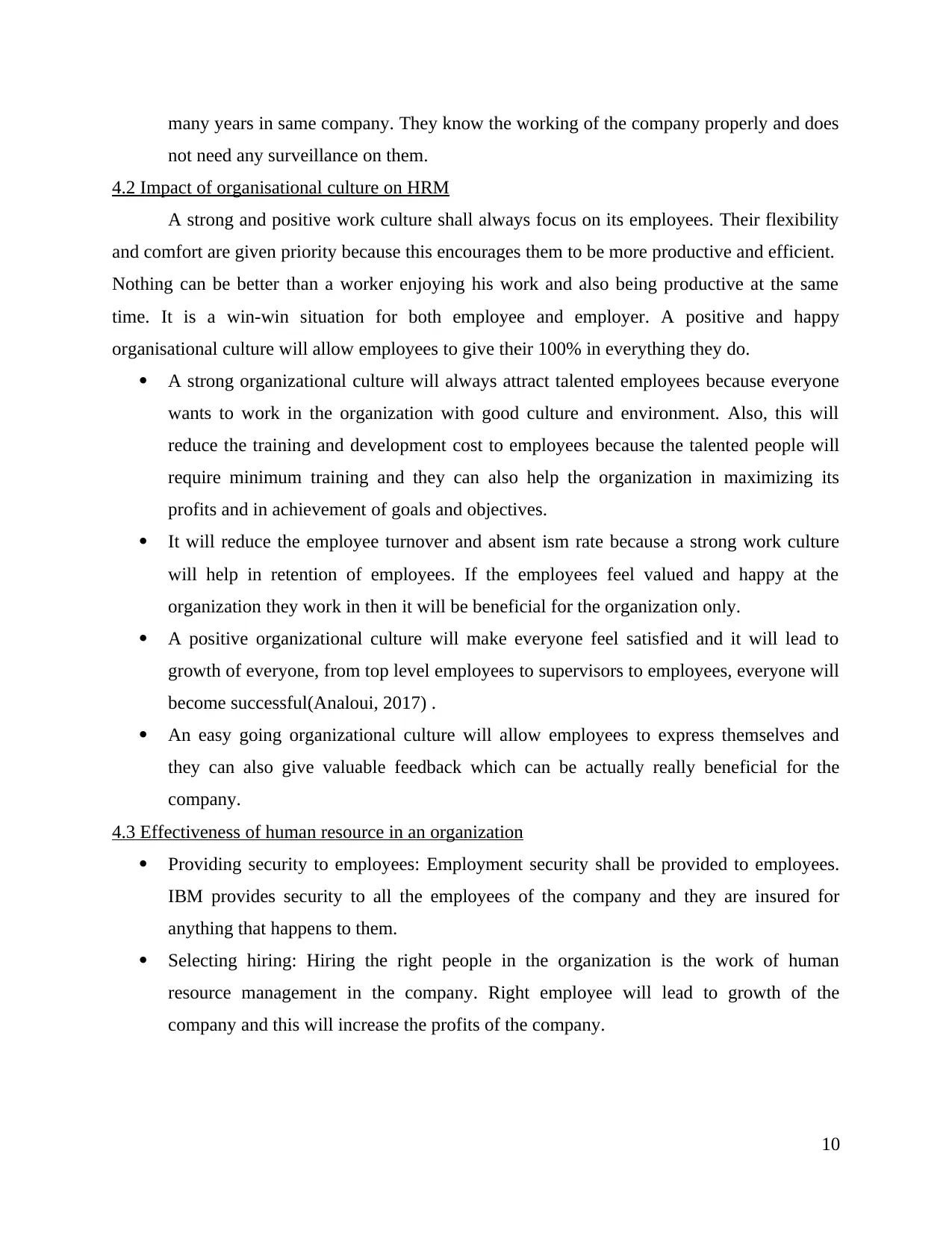
many years in same company. They know the working of the company properly and does
not need any surveillance on them.
4.2 Impact of organisational culture on HRM
A strong and positive work culture shall always focus on its employees. Their flexibility
and comfort are given priority because this encourages them to be more productive and efficient.
Nothing can be better than a worker enjoying his work and also being productive at the same
time. It is a win-win situation for both employee and employer. A positive and happy
organisational culture will allow employees to give their 100% in everything they do.
A strong organizational culture will always attract talented employees because everyone
wants to work in the organization with good culture and environment. Also, this will
reduce the training and development cost to employees because the talented people will
require minimum training and they can also help the organization in maximizing its
profits and in achievement of goals and objectives.
It will reduce the employee turnover and absent ism rate because a strong work culture
will help in retention of employees. If the employees feel valued and happy at the
organization they work in then it will be beneficial for the organization only.
A positive organizational culture will make everyone feel satisfied and it will lead to
growth of everyone, from top level employees to supervisors to employees, everyone will
become successful(Analoui, 2017) .
An easy going organizational culture will allow employees to express themselves and
they can also give valuable feedback which can be actually really beneficial for the
company.
4.3 Effectiveness of human resource in an organization
Providing security to employees: Employment security shall be provided to employees.
IBM provides security to all the employees of the company and they are insured for
anything that happens to them.
Selecting hiring: Hiring the right people in the organization is the work of human
resource management in the company. Right employee will lead to growth of the
company and this will increase the profits of the company.
10
not need any surveillance on them.
4.2 Impact of organisational culture on HRM
A strong and positive work culture shall always focus on its employees. Their flexibility
and comfort are given priority because this encourages them to be more productive and efficient.
Nothing can be better than a worker enjoying his work and also being productive at the same
time. It is a win-win situation for both employee and employer. A positive and happy
organisational culture will allow employees to give their 100% in everything they do.
A strong organizational culture will always attract talented employees because everyone
wants to work in the organization with good culture and environment. Also, this will
reduce the training and development cost to employees because the talented people will
require minimum training and they can also help the organization in maximizing its
profits and in achievement of goals and objectives.
It will reduce the employee turnover and absent ism rate because a strong work culture
will help in retention of employees. If the employees feel valued and happy at the
organization they work in then it will be beneficial for the organization only.
A positive organizational culture will make everyone feel satisfied and it will lead to
growth of everyone, from top level employees to supervisors to employees, everyone will
become successful(Analoui, 2017) .
An easy going organizational culture will allow employees to express themselves and
they can also give valuable feedback which can be actually really beneficial for the
company.
4.3 Effectiveness of human resource in an organization
Providing security to employees: Employment security shall be provided to employees.
IBM provides security to all the employees of the company and they are insured for
anything that happens to them.
Selecting hiring: Hiring the right people in the organization is the work of human
resource management in the company. Right employee will lead to growth of the
company and this will increase the profits of the company.
10
⊘ This is a preview!⊘
Do you want full access?
Subscribe today to unlock all pages.

Trusted by 1+ million students worldwide
1 out of 16
Related Documents
Your All-in-One AI-Powered Toolkit for Academic Success.
+13062052269
info@desklib.com
Available 24*7 on WhatsApp / Email
![[object Object]](/_next/static/media/star-bottom.7253800d.svg)
Unlock your academic potential
Copyright © 2020–2025 A2Z Services. All Rights Reserved. Developed and managed by ZUCOL.





